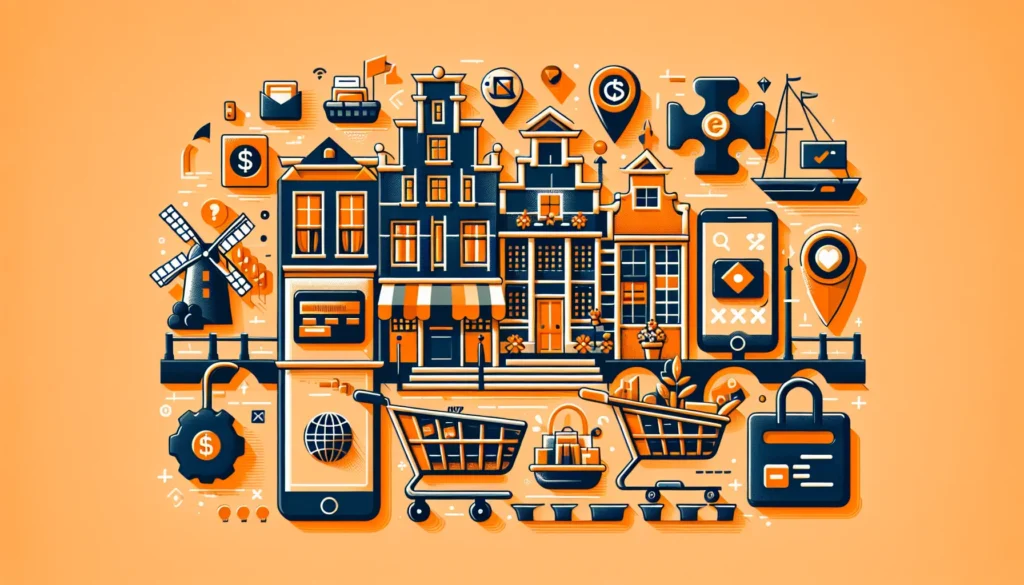The era of 24/7 shopping has arrived thanks to e-commerce. A plethora of benefits can be gained from online shopping: a wider reach of customers, the convenience of shopping anywhere and anytime, and the ability to have the entire internet catalogue at your fingertips.
In Europe, more than half a billion people used online shopping by 2023. The Netherlands ranks seventh in terms of the largest e-commerce markets in Europe, with more than three per cent of gross domestic product (GDP) coming from online shopping. In 2022, the Dutch e-commerce industry was valued at €33.3 billion, with more than 340 million online orders. The Dutch e-commerce market has grown by almost €20 billion over the past decade and shows no signs of slowing down.
The Dutch online shopping cart
Online shopping is done most often in the 25- to 44-year-old age group, with more than 94 per cent of consumers saying they have bought goods on the internet. Men tend to shop online more than women, with a difference of almost five percentage points. However, the gender gap in online shopping is slowly starting to close. As of 2022, Dutch women shop more than ever, with a percentage of more than 85 per cent. For both genders, clothing, shoes and accessories are among the most popular products to buy online. Fast-growing product segments in turn include tickets, attractions, events and travel packages - all sectors returning in the recovery after COVID-19.
Who are the biggest online shops in the Netherlands?
The online retail industry in the Netherlands is largely dominated by domestic companies. The largest online shops in the Netherlands include local players such as online hypermarket Bol.com, electronics shop Coolblue, and supermarket Albert Heijn. With a significantly lower share of visits than other Dutch e-commerce sites, e-commerce giant Amazon is still among the most popular platforms, but as many as 96 per cent of Dutch consumers buy on domestic sites compared to only 40 per cent on foreign websites.
Still, the quarterly outlay for cross-border purchases in Foreign webshops, is a considerable amount.
Dutch Consumers choose US and German web shops: billion Euros per quarter
Each quarter, Dutch people spend about one billion euros on purchases abroad, indicating that cross-border shopping is a substantial part of Dutch consumption habits. Mainly focused on products from the United States and Germany, cross-border online shops from these countries appear to be favoured by Dutch consumers. The emerging trend also indicates that media and entertainment, such as streaming services, games and electronics, will be the most popular categories for Dutch people shopping abroad in the coming years. With a growing global market and the convenience of online shopping, borders seem to be less and less of a barrier for Dutch consumers.
Dutch people buy a wide range of products from foreign webshops. Some popular categories are:
Electronics: this includes products such as smartphones, laptops, tablets, and other gadgets that may be cheaper abroad or offer a greater variety.
Clothing and shoes: Dutch people are often looking for specific brands, styles or price ranges that may not be readily available in Dutch shops.
Media and entertainment: this includes streaming services, digital downloads of music, films, games, and other forms of entertainment that may be exclusive to certain regions.
Cosmetics and personal care products: Dutch people can find products that are not available in the Netherlands or whose price is more favourable abroad.
Specific products or niche items: these can be unique or specialised products that are not easily found in Dutch shops, such as hobby items, special foods, or culturally related items.
Payment and delivery preferences
Dutch customers prefer to use mobile apps and bank transfers for their e-commerce payments. Major national banks have been collaborating with online banking apps for years, moving the majority of Dutch banking activity into the digital sphere. The high use of bank transfers is due to the popularity of iDEAL, a Dutch interbank system that allows shoppers to use their bank accounts for online purchases. Nine out of 10 online shoppers used iDEAL for online payments in 2022. International payment providers such as Google Pay, Apple Pay and Paypal are also slowly finding their place in the Dutch e-payment market. However, like Amazon, these corporate giants are still lagging behind the Dutch national market leaders.
Direct-to-consumer trend
Rise of D2C brands in the Netherlands Direct-to-Consumer (D2C) brands are gaining popularity in the Netherlands by selling directly to consumers, without the intervention of third parties. This creates more transparency and control over brand image.
Benefits of direct customer relationships for brands Direct contact with customers allows brands to receive feedback directly, resulting in faster product improvements and higher customer satisfaction.
Disruption of traditional retail models
The rise of D2C brands is causing a shift in the retail sector, with traditional retailers having to rethink their strategies to remain competitive in a rapidly evolving landscape.
EU policies
European Union regulations have a considerable impact on e-commerce in the Netherlands. The harmonisation of rules within the EU facilitates cross-border trade for Dutch online retailers. The digital internal market strategy EU stimulates growth and innovation.
Advantages:
Simplified trade within the EU
Increase in consumer confidence
Encouraging competition and choice
Disadvantages:
Possible restrictions due to strict regulations
Challenges in complying with various national laws
Potential costs of adapting to new regulations
The General Data Protection Regulation (GDG) or GDPR plays an important role in protecting personal data for online retailers in the Netherlands. Ensuring the privacy of customer data is essential to build trust and comply with legal requirements. Through transparency and adequate data security measures, companies can comply with GDPR standards.
Cooperation between EU member states promotes cross-border e-commerce by removing barriers such as different tax systems and regulations. Working towards a harmonised digital market facilitates doing business across borders, benefiting both consumers and businesses.
Brief summary of e-commerce figures
- Dutch e-commerce is growing steadily and reached a value of €33.3 billion by 2022, with more than 340 million online orders.
- Most online shoppers are between 25 and 44 years old, with men shopping online slightly more often than women, although the gender difference is decreasing.
- Popular online purchases include clothing, shoes, accessories and fast-growing segments such as tickets, attractions, events and travel packages.
- Although Dutch e-commerce is dominated by domestic companies, quarterly spending on cross-border purchases amounts to one billion euros, with media and entertainment being the most popular categories.
- Every three months, Dutch people spend about one billion euros on stuff they buy abroad.
- The most popular foreign webshops the Dutch buy from are those from the United States and Germany.
- Dutch customers prefer mobile apps and bank transfers for payments, with iDEAL being the most widely used payment system, although international providers such as Google Pay and Apple Pay are slowly gaining ground.
"Want to know more about how your business can benefit from the growing e-commerce market? Get in touch today with G365 Marketing For a tailor-made strategy!"
Source: Statista





